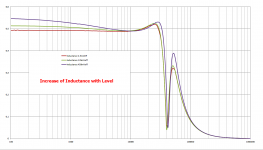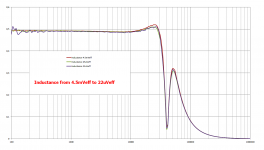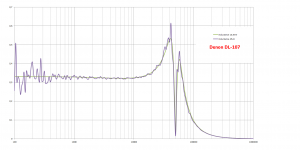As far as I understood, JP can only work on the system in the weekends.Thank you JP, just crunching it.
Do you know what CV velocity the sweep is recorded at, or can you deduce it from the reference 1kHz tone on the Ortofon record?
If you do run a 33rpm sweep, would you kindly post a dropbox link?
thx again LD
So I will do the 1khz 5cm/sec recording tomorrow and report the level in comparance to the 33 1/3 sweep.
You probably have read my posting where I mentioned that as from 20kHz, the signal seems to be going upwards with 20dB/dec, at least that is what JP's recording shows.
Now looking at the test-record again, I see printed on the cover behind the sweep (800 - 20000Hz +/-1.5dB).
So It doesn't tell anywhere it should be flat up to 50kHz.
Before I contact Ortofon, I will also have to wait for JP's sweep recording at 33 1/3 rpm.
Hans
It's intriguing to see how wrong some manufacturers specifications are on L and R. Ortofon are close on R and way out on L and AT the other way around. I guess they didn't think it 'that' important.
But looking at the numbers for the DL-107 (for which I cannot find any manufacturer specs online) it wins the award for weirdest combination so far. R is nearly 6x L. This makes it a significant outlier and no idea how they got to that unless very very thin wire.
But looking at the numbers for the DL-107 (for which I cannot find any manufacturer specs online) it wins the award for weirdest combination so far. R is nearly 6x L. This makes it a significant outlier and no idea how they got to that unless very very thin wire.
@LD,
Are you satisfied this far with the info's concerning inductance versus different voltages on the OM-10?
If you have no more questions, I will put things back in the box to be returned to Bill tomorrow.
Hans
Are you satisfied this far with the info's concerning inductance versus different voltages on the OM-10?
If you have no more questions, I will put things back in the box to be returned to Bill tomorrow.
Hans
Apparently bipolar input m5220 was better with high impedance input than all other bipolar and fet input as they were extensively used in good quality cassette players and i tried them against opa1642 and opa2132...They both lost by a mile to m5220 with no tape playing and muting circuit deactivated in a high quality pioneer cassette deck.I didn't try njm2068 though as in my pioneer player the network impedance was a bit too low for njm2068 capabilities.opa2227/2228 is better but too low power supply for phono.How so?. Stylus up the noise spectrum is dead perfect RIAA shaped white noise w/47K||250pF. JFET op-amps of the day were 8-14nV and were not particularly suitable for any MM input.
Looking in its datasheet m5220 was made for phono preamp with +-25 v max supply , very low noise and high output power.A.N.T said that he had measured about 1 meg ohm impedance at 20khz .
Interesting tests, What did you determine to be the ideal cartridge load?
I am using mine at 150k // 47pf.
those m5220's really are super low noise. I would have kept them if one didn't die during extraction from SX3700
GPAPAG, I got a very similar response to yours using a 470k resistor to the phono input with cart attached to iphone sig generator. Output was from the RIAA op amp. I have a low noise front end Zin = 700k at 20khz silicon only.
I am using mine at 150k // 47pf.
those m5220's really are super low noise. I would have kept them if one didn't die during extraction from SX3700
GPAPAG, I got a very similar response to yours using a 470k resistor to the phono input with cart attached to iphone sig generator. Output was from the RIAA op amp. I have a low noise front end Zin = 700k at 20khz silicon only.
Last edited:
GPAPAG, I got a very similar response to yours
Hi stocktrader200.
Can you please write the post number to which you are referring to?
George
A bit oblique -- putting T5 ahead of the first stage using 47k load -- a Hammond 3H costs $14:
Same result as the Damped RIAA Bob Cordell used (which has its roots in the Barney Oliver design). I am sure the lots of iron brigade will love it, but its a fairly extreme way to avoid replacing the 47k with something smaller 🙂.
Still not worked out best approach for DL-107 but checking numbers last night and turns out superOM is not suitable for 2L-R loading despite the spec. AT150 still can be 2L-R loaded but at half the loading the spec suggests. This at least proves that, without an accurate way of measuring L the aurak approach is tricky.
But based on this no reason for me to leave mine on 2L-R loading so I will convert to 3L
But based on this no reason for me to leave mine on 2L-R loading so I will convert to 3L
Thx Hans - mostly I was interested in dynamic inductance variation with level: based on a thesis that also would reflect in the transfer characteristic of the coil/core as a generator. But that is prob sunk.@LD,
Are you satisfied this far with the info's concerning inductance versus different voltages on the OM-10?
If you have no more questions, I will put things back in the box to be returned to Bill tomorrow.
Hans
I'm still interested in repeating the observed OM10 variation with/without stylus assembly fitted (appols if I missed it?). Also in knowing if there's any variation at small signal levels for one or two other carts if it's easy and you're up for it (but there prob isn't) ?
Thx LD
@LD Note that SuperOM10 is the one I did promise to send to you (mumble) ago, so when back it will finally make the journey for you to have a play with.
Thx Bill - that gives me incentive to gather my test records and misc test rigs and arms from various locations. Aside, I found my EF184 valve version of Aurak in the workshop the other week...……..it worked well, but I never got round to casing it.
LD
LD
I found it OK for the fundamental, but there's some weird large fluctuations in harmonic distortion between samples above 17kHz...……… just trying to understand that, but seems real...…?At 45rpm there are a lot of missing frequencies even at 10ms sample windows because the exponential sweep is going so fast at the end.
LD
I found it OK for the fundamental, but there's some weird large fluctuations in harmonic distortion between samples above 17kHz...……… just trying to understand that, but seems real...…?
LD
At 33 1/3 there are very few missing frequencies. One approach would be to have an adaptive time window, as it is the low frequencies are over sampled.
Thx Hans - mostly I was interested in dynamic inductance variation with level: based on a thesis that also would reflect in the transfer characteristic of the coil/core as a generator. But that is prob sunk.
I'm still interested in repeating the observed OM10 variation with/without stylus assembly fitted (appols if I missed it?). Also in knowing if there's any variation at small signal levels for one or two other carts if it's easy and you're up for it (but there prob isn't) ?
Thx LD
LD, no problem that you missed my posting, because in the meantime I could reduce filter bandwidth to a few Herz, giving even more detailed and accurate info.
Now I can say that I see no difference in the inductance with or without Stylus Assembly.
Below 2 images , one with Level going up from 4.5mVeff to 450mVeff , showing the increase in inductance when level goes up and a second set going down from 4.5mVeff to 22uVeff where the inductance doesn't change.
450mVeff on the Cart seems a lot, but with the 4k7 in series current max is only 80uA.
Hans
Attachments
LD,Thank you JP, just crunching it.
Do you know what CV velocity the sweep is recorded at, or can you deduce it from the reference 1kHz tone on the Ortofon record?
If you do run a 33rpm sweep, would you kindly post a dropbox link?
thx again LD
comparing the Ortofon sweep at ca 1kHz against the 1kHz 5cm/sec tone on the same record, calculated in a -4dB weaker signal for the sweep.
In my case 489mV vs 780mV from the flat amp.
Hans
gpapag, post #961 where you plot the Zout. The frequency response with 470k resistor to phono input is flat from below 100 to 1.5khz then is up about 12db at 20khz. I have a boost in at 30Hz of +4 db.
I have forced my preamp to output frequency response of a CD by comparing LP & CD versions of the same song. notably left and right are eq'd slightly differently.
I have forced my preamp to output frequency response of a CD by comparing LP & CD versions of the same song. notably left and right are eq'd slightly differently.
Thank you, Hans.….comparing the Ortofon sweep at ca 1kHz against the 1kHz 5cm/sec tone on the same record, calculated in a -4dB weaker signal for the sweep.
In my case 489mV vs 780mV from the flat amp.
That makes 3.15 cm/s rms - let's call it pi and that's the sort of constant physicists can handle 😉
LD
Since the Denon DL-107 Cart was quite special in its characteristics, I tested this one also, just before it goes to someone else, for the effect of level on the inductance.
Since Rc of this Cart is very large, it is noisier at 45uV as the Ortofon OM 10 with the used 4k7 in series.
A different series resistor would have given a better result, but it is quite obvious from the image below that also this Cart has a constant Inductance value from 13.5mV to 45uV, a range of almost 50dB.
This is yet another "prove" that Inductance of a Cart is independent of level within the Audio level range.
Hans
Since Rc of this Cart is very large, it is noisier at 45uV as the Ortofon OM 10 with the used 4k7 in series.
A different series resistor would have given a better result, but it is quite obvious from the image below that also this Cart has a constant Inductance value from 13.5mV to 45uV, a range of almost 50dB.
This is yet another "prove" that Inductance of a Cart is independent of level within the Audio level range.
Hans
Attachments
If you do run a 33rpm sweep, would you kindly post a dropbox link?
Ya have one just on wrong computer. Hopefully this weekend I'll remember to turn on remote desktop at the house so I can at least grab files while away.
@JP I fixed the 45 rpm sweep at high frequencies, I over thought the problem the plot routine already interpolates over missing frequency bins. At 45rpm there are a lot of missing frequencies even at 10ms sample windows because the exponential sweep is going so fast at the end. I'll send you something for next weekend. Everything agrees again.
Sweet send it over.
- Status
- Not open for further replies.
- Home
- Source & Line
- Analogue Source
- Cartridge dynamic behaviour



